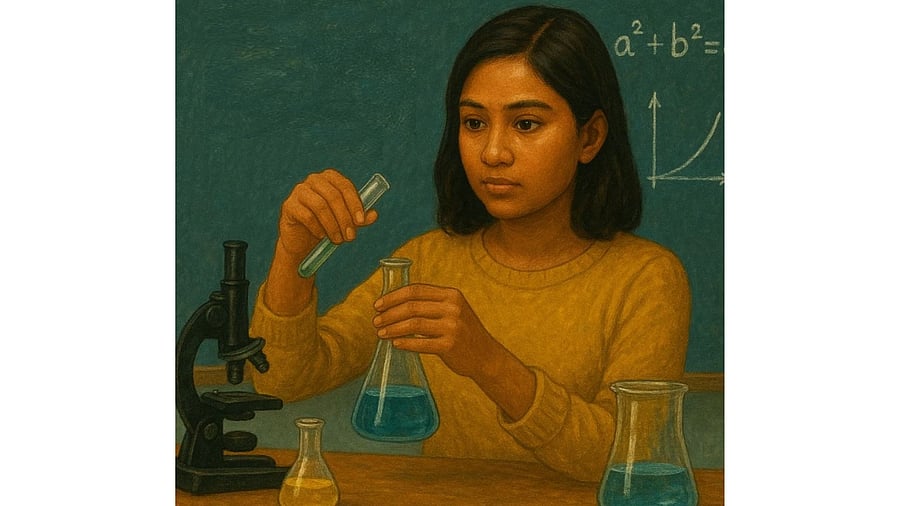
Representative image
Credit: Special Arrangement
Each year, lakhs of young Indians graduate from colleges and universities with impressive marks, yet a troubling number struggle to find meaningful employment. Employers across sectors lament that even top scorers lack problem-solving ability, creativity, communication, and professional competence. This paradox of high marks but low skills has become the defining crisis of Indian higher education.
The system still rewards rote learning and memorisation over understanding and application. Examination patterns test the ability to recall information rather than to think critically or use knowledge in new contexts.
As a result, students learn to play safe—to reproduce what is taught rather than question, connect, or create. Classrooms remain teacher-centric, where notes and PowerPoint slides substitute for exploration and discussion.
The National Education Policy (NEP) 2020 recognises this deep malaise and calls for a shift towards outcome-based and multidisciplinary learning. Yet, the transformation it envisions cannot occur through policy documents alone. True change must happen within classrooms—in teachers' attitudes, the structure of assessments, and the freedom students are given to experiment and fail.
Models of change
There are, however, models that prove change is possible. The Indian Institute of Science (IISc), Bengaluru, involves undergraduate students in research projects from the very first year, encouraging them to question, experiment, and publish.
The Tata Institute of Social Sciences (TISS) integrates fieldwork into every programme, ensuring that theory meets reality and that students learn empathy along with expertise. Amrita Vishwa Vidyapeetham’s “Live-in-Labs” initiative sends students to rural communities to design and implement sustainable solutions, linking classroom learning directly to social transformation.
Beyond India, universities like Aalborg in Denmark have pioneered Problem-Based Learning, where students learn by solving real-world problems in teams. The University of Waterloo in Canada has built a strong co-operative education model that alternates academic study with paid industry placements.
Both approaches bridge the classroom and the workplace, producing graduates who can think, adapt, and contribute immediately. These examples show that marks alone are not the measure of success—learning outcomes, innovation, teamwork, and social impact are.
In my Data Structures class, I have introduced open-book exercises, quizzes, and projects. I have seen a marked improvement among my students, especially undergraduates, who have been able to learn, not merely memorise code for exams.
Redesign education
If Indian universities hope to produce globally competent graduates, they must redesign their systems around learning-by-doing. Internships, field projects, research components, and interdisciplinary courses should become integral, not optional. Assessment must shift from memory-based exams to performance-based evaluations—presentations, portfolios, case studies, and group projects that demonstrate skill and understanding.
Equally crucial is the teacher's role. Faculty members need continuous professional development to move from mere “deliverers of content” to “facilitators of learning.” Universities should invest in training teachers in pedagogy, mentoring, and technology-enabled instruction. Learning management systems, simulation labs, and project-based assignments can make classrooms dynamic spaces where curiosity thrives.
Industry-academia collaboration is another missing link. Employers should not remain passive consumers of graduates but active partners in shaping curricula. Joint projects, guest lectures, internships, and co-designed courses can align education with evolving workplace realities. This would also help students discover the relevance of what they learn and see knowledge as something alive and usable.
True reform also demands a change in how society perceives education. Parents and students often equate success with marks and degrees rather than competence and character. Unless we move from the question “How many marks did you get?” to “What did you learn and how can you use it?”, the crisis will persist. Education must return to its true purpose—to form thinking, caring, and capable human beings.
The future of India’s youth cannot depend on inflated grades or ornamental degrees. It must rest on genuine learning—on the ability to question, collaborate, and create. The examples of IISc, TISS, and Amrita show that transformation is not a distant dream but a matter of will and vision. If universities reimagine education as a process of doing, discovering, and contributing, they can bridge the dangerous gap between marks and mastery.
Only then will India move from producing graduates to nurturing learners — and from chasing high marks to achieving high competence.
(The author is the director of the IT section of a Bengaluru-based deemed-to-be University)